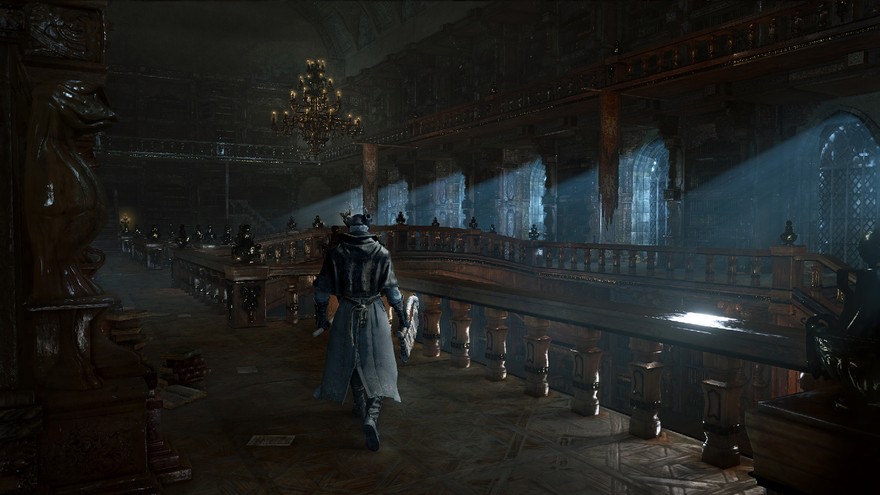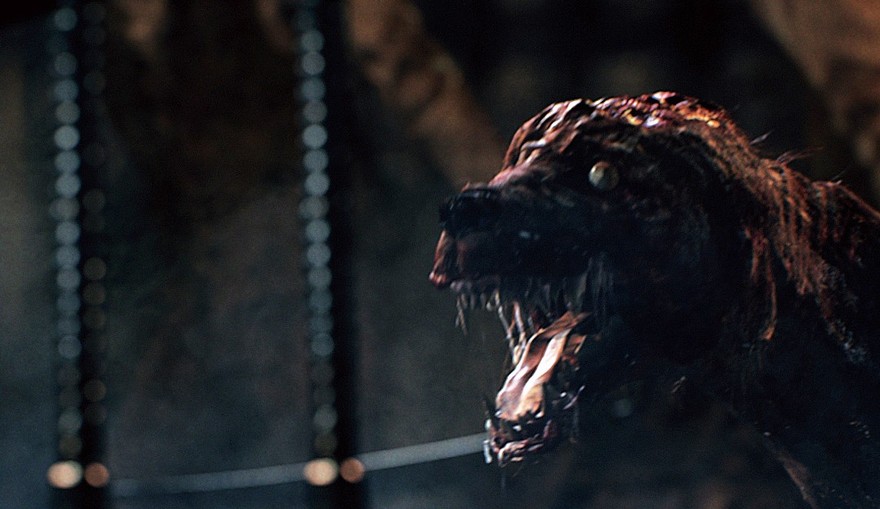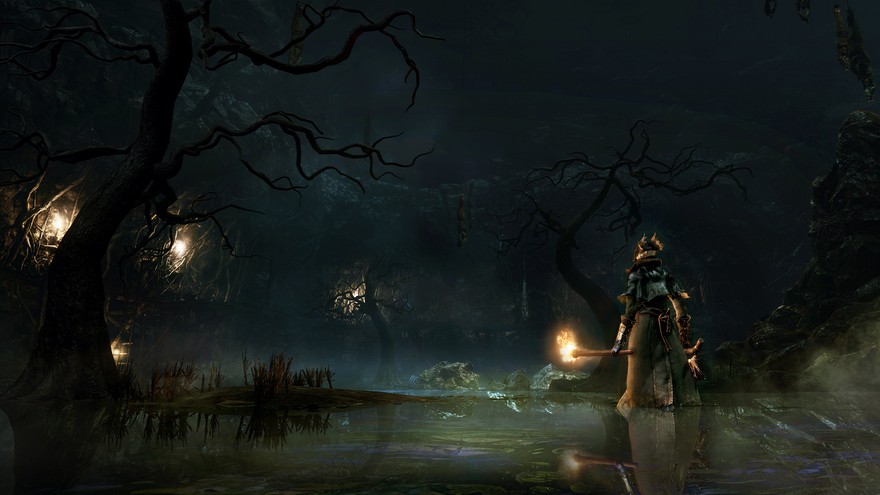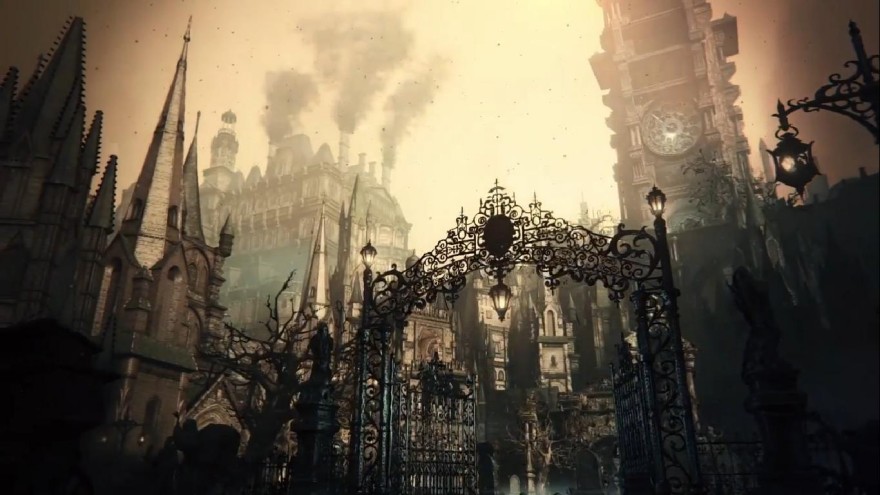Bloodborne’s director, Hidetaka Miyazaki, is an odd figure. Softly spoken, unremarkable at a glance, he neither courts a public persona nor spurns it. You won’t find him tweeting pictures of his lunch, or at GDC, and he rarely discusses other games in public. Despite the success of Dark Souls he seems like a man almost unaffected by his own rise to prominence and by FROM Software’s growing hoard of accolades. For this reason, anecdotes about his creative process are like hidden treasures, waiting in the shadows for those curious enough to hunt them out.
Perhaps the most telling is found in the back pages of Dark Souls: Design Works, amid images of freakish beasts and ancient armour. In it, one of the handful of art designers of the game, Masanori Waragai, tells how he brought a design for the game’s undead dragon to Miyazaki. Looking at the sketch of a disgusting beast, swarming with maggots, Miyazaki chastised Waragai for relying on gross-out imagery: “Can’t you instead try to convey the deep sorrow of a magnificent beast doomed to a slow and possibly endless descent into ruin?” It’s a passing note, like any game director might offer, but you can tell by the way Waragai specifically mentions it that it has stuck with him. This idea seems to stick with Miyazaki too, emerging again and again in different interviews. In them Miyazaki sometimes refers to a desire of his, a quest. Though many see his games as brutal and unforgiving, he explains that his desire is not to punish players. Instead, in carefully chosen words, delivered in precise Japanese, he explains that his desire, his quest, is to create something of beauty.
///
The magnificent city of Yharnam began its slow and endless descent into ruin long ago. When you take your first cautious steps into its cobbled streets, you are not stepping into a teeming world, but a corpse of a city, locked in the throes of death. When one of its psychopathic residents, all wild-eyed and shock-haired, lying in a pool of his own blood, mutters, “This town is finished,” it’s difficult not to agree. That man I just slashed to ribbons, you think, has a point. So goes the first hour of Bloodborne; being laughed at by residents smart enough to hide indoors, plotting a tentative route through ornate streets and getting pulped by a giant holding an equally giant brick. Bloodborne instantly makes an impact, so to speak, and it is the setting of Yharnam that carries the weight. None of Miyazaki’s other worlds—not the districts of Boletaria nor the peaks and troughs of Lordran—have ever felt so disgustingly real. Hours after you drag yourself out of the dingy corners of central Yharnam to the heights of the Cathedral Ward, buffeted by the winds that tell of a coming storm, you’ll gaze down on the spires and spindly alleys and almost think it looks peaceful. Almost beautiful.

It is, in fact, a place of fear and superstition. From the rolling graveyards that climb up to the high cathedral and then back down to a shrouded forest; from the depths of a corpse-strewn aqueduct to the arcane academy set on the shores of a moonlit lake; its strength lies in its commitment to a tragic sense of decaying beauty. Comparisons are easy to make, and should be made with Dark Souls’ seminal world of Lordran, but in reality these are two very different beasts. While Dark Souls revelled in twisting fantasy stalwarts like lava, sewer and castle into a distinctive sprawling whole, Bloodborne builds a world that follows its own rules towards a perverse and chilling logic. This is a city that feels like a nightmare vision of old Europe, with its bridges and spires, squares and alleys. There is a distinctive atmosphere that is carried through each area with a sense of restraint and an unflinching eye for detail. Statues and carvings each tell their own story and Yharnam feels like the most storied of cities—its strata made up of alternating layers of bricks and bodies.
Unlike the Souls games’ static mobs, enemies wander through this rich territory, whether it is the crazed hunters who keep the residents on lockdown, or the somber members of the Church, who patrol their lofty home. When I first came up behind one of these sanctimonious stoics as he gazed out across the fog-laden lower city, I almost felt a sense of sadness as I drove my cleaver home. Only Dark Souls’ angelic butterflies could elicit a similar moment of emotion, but there was little purpose to this pity. Bloodborne, meanwhile, sparkles with moments of rare delicacy—the gasp of a doll as she wakes from a dream, or the desperate prayers of a woman whose fate is already sealed. The game provides a clear context for this tragedy through the institutions and hierarchies of its world. The Healing Church, the grand institution at the heart of Bloodborne, is decaying as rapidly as the city around it, and in it Miyazaki finds a potent mix of purity and corruption. Its abandonment of its citizens as well as its academic pursuit of darker arts grows into a central theme throughout the game. Religious devotion is as skewered by Bloodborne as its many beasts, the point sharpened by a precise focus in both art and design.
///
This sharpening is also mechanical in nature, like the winding of a clockwork toy. In fact, we might think of Miyazaki as an expert toy-maker as well as a visual artist, his macabre creations ratcheted up and up in intensity with each new iteration. Bloodborne’s interlocking systems are very much a development of everything Miyazaki has done before, but they are also an aggressive revision that effectively supports the themes shown elsewhere. These changes go way beyond change for change’s sake, and speak of the pursuit of a single aim. The lack of equipment weight ratings, meaning your character remains nimble no matter your loadout, is both the most natural and the most significant. When combined with a swift sidestep dodge, it allows for surprisingly balletic feats in combat, with barely a glance at your stamina bar as you bounce from target to target, slipping under attacks and slicing through defenses. Waltzing into a room with a mix of melee and ranged enemies usually heralded a hasty retreat in Dark Souls, but in Bloodborne it’s the perfect opportunity to show off. This unchained aggression is supported by the regain system, which allows you to claim back lost health by dealing damage within a short window. The result is combat across multiple axes of movement, instead of Souls’ ubiquitous circle-strafing. One boss found in the Grand Cathedral tests this to an extreme, requiring feint and move tactics at a dizzying pace up until its wailing end.
The game’s weapon selection follows this sharpened and stripped-back trajectory, providing a simpler arsenal with a rich sense of tactical variety. This is perhaps the most confident element of Bloodborne’s combat design, with the developers unafraid to dish out guns and blades that fundamentally change your approach. Wielding a wide sweeping flamethrower rather than an attack-interrupting pistol makes for a complete change of pace, but being able to fast switch between the two means that player skill becomes the lone limitation. There are shades of Bayonetta to this generous skill-set, and additional customization in the form of blood gems provides the chance to construct highly specialized builds. But the real showcase element are the trick weapons, which provide two approaches in a single package, linked together with combat animations that fizzle with violent potential. My own weapon of choice, the threaded cane, provides both staggeringly fast blunt strikes, and a razor-edged whip that slits throats at ten paces. This relationship between styles that opens up over multiple hours, with constantly shifting enemy types providing the catalyst for new approaches. It’s a daring and ambitious approach for a studio known for purposeful hack-and-slash rather than extravagant bloodletting, and while the lock-on and camera occasionally struggle to keep up, it is a startling success.

However, the most important effect of this mechanical prowess is the way in which it supports the the darkness of Bloodborne’s world. In this sharpened and blood-soaked guise there is no chance of the player being mistaken for a hero, just as the crippled crows and crawling corpses of Yharnam cannot be mistaken for all-powerful enemies. Every creature, not just the player, is fighting to keep a desperate grip on its ugly, bloody life. This desperation gives a minor tone to the violence that makes things very clear: Miyazaki has cast the player as both witness and executioner, and our task is to see Yharnam’s rasping lifeless end.
///
To understand Bloodborne’s place in Miyazaki’s body of work, it must be positioned alongside Demon’s Souls and Dark Souls. With its lamps and blood echoes replacing bonfires and souls, the game supports this view. However, using this structure as a critical yardstick is reductive. For example, looking at Bloodborne through the spectrum of Souls, it is easy to see its highly reduced item, armor and weapon count as presenting both less equipment variety and delivering less lore. But neither of these things are lacking in Bloodborne, with much of the game’s lore now being embedded into the visual design, enemy selection and details of each area, rather than being delivered in item descriptions. The reduction in armor and weapons, meanwhile, has simply excised the glut of useless items that saw Dark Souls 2’s armory mostly remaining unused by players. Miyazaki’s relationship to his own lineage is a playful one, and while he is happy to riff on familiar encounters, to simply view his work through these repeating patterns neglects the stronger aspects of his games.
The game’s chalice dungeons are among the most important reasons to separate Bloodborne from its parent series. At first, these randomly generated labyrinths appear to be empty and disjointed, completely unlike the precise and ornate level design of Yharnam. Systematically clearing them of enemies in order to loop back round to the boss room has little of the satisfaction that can be gained from the same process in the main game, but with a little reconsideration they suddenly begin to make sense. In short, the chalice dungeons reimagine Bloodborne as an arcade dungeon crawler, where speed, skill and a honed sense of direction carry you through all kinds of traps and trials. Taking the chalice dungeons at a full sprint, dodging enemies rather than killing them, and hoovering up items becomes a compelling metagame in itself. As these labyrinths work on their own economy, in which victory opens up new ingredients with which to build fresh challenges, there is also a clear motivation for this speedrun attitude, as it is items, not enemies, you are after. The only beasts that must be killed are the bosses that end each level, which are shuffled into different arenas with a surprising impact on tactics. Fighting a man-eating boar is a completely different prospect when the low vaulted room you are in is filled with destructible pillars. Its easy to see how, months from now, extreme speed-running feats will make these spaces seem more filled with potential than they are right now. Their shifting combinations only need fervent players to be brought to life, and Bloodborne is sure to have plenty of those. However, it’s not simply a case of taking Bloodborne on its its own terms, but about understanding that its origins lie in more than just From Software’s distinctive action role-playing games.
///
Miyazaki is known for bringing literature to design meetings, circling passages and handing them over to artists, asking them for their own interpretation. In Bloodborne these literary connections are evident, with the works of H.P Lovecraft hanging over its dark world like a veil. Bram Stoker’s Dracula and Mary Shelley’s Frankenstein also have echoes in this world—not in their pulp, Hammer Horror forms, but in the texture of their original and ornate prose. For Miyazaki, it’s clear that these are not just style references, but the seeds of his world. After all, the focus of these iconic gothic texts is not a sense of horror but a sense of humanity lost, and of the darkness that lies in the subjective spaces of human experience. Meanwhile, it is difficult not to look at the towers and spires of Yharnam, and not to think of Gormenghast, the grand gothic castle created by writer Mervyn Peake. In it, old dying institutions locked to endless rituals echo around once-glorious halls. Bloodborne’s interest in ritual and religious institution, as well as its empty but charged edifices, seem to speak directly of Peake’s worldview, one which depicts the powerful draw of fantastic dreams coloured by a pessimistic view of the waking world. Peake’s works were irrevocably affected by his experience of living in a time of European war, and Bloodborne is perhaps the first game of Miyazaki’s to suggest that he too is influenced by an ever-darkening modern world.
With this in mind, if Dark Souls is medieval gothic—its dichotomies of heaven and hell gestured at by pointed arches, supporting both a true spirituality and a belief in the divine—then Bloodborne is the epitome of gothic revival—where subjectivity replaces spirituality, and man strives to plumb the depths of human experience. Its Victorian trappings are not simply window dressing, but the marks of a distinct gothic worldview that finds its roots in the work of philosopher Edmund Burke. This, in reality, is the beauty that Miyazaki so regularly mentions, one reached through the contemplation of that which is unknowable. It was Burke who presented this idea in his 18th-century treatise A Philosophical Enquiry into the Origin of Our Ideas of the Sublime and Beautiful, inspiring a whole generation of writers to cast their eyes to the dark in search of something both human and inhuman all at once. The sublime is a kind of terror found in nature, one that surpasses beauty itself. It is inspired by the unknown, by the inconceivable in the world around us. It was this idea that drove Victorian writers and architects to look back at the spaces and atmospheres of Medieval Gothic, to pointed arches and ornate tracery, to ruins and ruined institutions in search of the effect of the sublime.

Miyazaki, too, seems to be motivated by this same quest, a quest to realize that which is terrifying, opaque and distant in order to harness the effects it inspires. Looking at Bloodborne as part of this obsessive pursuit is a way to begin to see what lies behind Miyazaki’s composed exterior. It is easy to see him as an director haunted by demons, but in reality his quest is one driven by something more mysterious and distant. There is a digging, a scratching away at something in all of his work, as if he is chasing the dangling end of something as it quickly recedes. Bloodborne, in its focus, represents Miyazaki starting to get a grip on this end, and beginning to systematically follow its trail.
This is not a unique position that only Miyazaki occupies; instead, it connects him to a legacy of directors and artists that have returned again and again to the same fertile ground. We might see Miyazaki’s pursuit of an austere and powerful visual language as analogous to William Blake’s obsessive paintings of biblical suffering; or his honing of gameplay mechanics as similar to Andrei Tarkovsky’s pursuit of the metaphysical powers of the long shot. Both of these creators saw beauty in what they were hunting—not a general, normalised beauty, but a specific, intense beauty, intrinsic to their very nature. This process goes beyond the task of making “good games,” and becomes something else—a creative act driven by both love and obsession. Bloodborne is built on this transcendent love. A love of the crumbling ruin, of the screeching banshee, of the shape in the shadows whose eyes catch the candlelight. A love of heaven-scratching spires, ever-descending staircases and fog-cloaked alleys. A love of all the magnificent horrors that have filled the minds of humans since they learned to light fires to stave off the dark. Lamps are, in truth, just another kind of bonfire, but the dark is always shifting, and it is on this shifting form that Miyazaki has set his precise and studied gaze.
